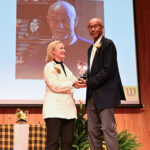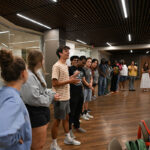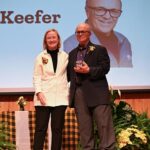
Environmental geoscience major combines two passions for senior research
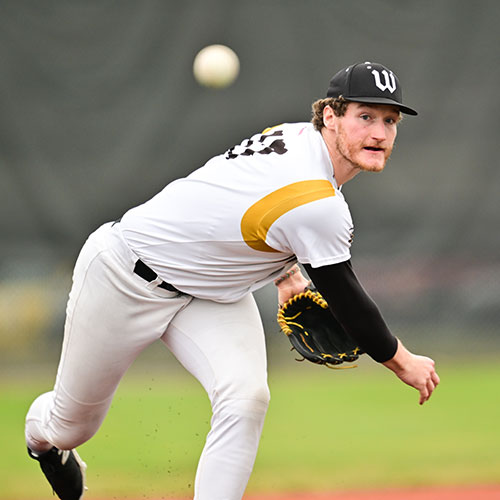
Virginia native Corey Knauf ’24 has played the game of baseball for nearly his entire life. Just like a pitcher comes set for each pitch he throws, this 6-foot-4-inch right-hander knew choosing to attend The College of Wooster would set him up well for a career. He sought out a school that highlights academics and offers a competitive baseball team. “Wooster fit that category perfectly,” said Knauf.
When the time came to choose a senior Independent Study topic, he wondered if he could repeat the magic he found in the college-selection process to feature both academics and athletics. “The classes I took in earth sciences really taught me that I could apply a research project to both baseball and geoscience,” explained Knauf.
One of those classes was Earth Materials, taught by Meagen Pollock, professor and chair of earth sciences. “Dr. Pollock’s class introduced me to rocks and soil properties and really sparked my interest,” said Knauf. He pitched the idea of studying the stickiness and effectiveness of baseball rubbing mud. The department “immediately loved it,” as did Pollock, who jumped on board as Knauf ’s I.S. mentor.
The Lena Blackburne Rubbing Mud is the standard mud used by all Major League Baseball teams and many National Collegiate Athletic Association teams (including the Fighting Scots). Since the 1930s, this “magic mud” has been used as a safety measure to improve the grip and dull the shine of new baseballs before each game. Knauf wanted to know what made it special.
His research compares the Blackburne product to a common alternative, softball mud, and a mud made from random soil. Knauf collected the latter from a construction site during his summer 2023 internship with a geotechnical consulting firm in Virginia. The firm tests soil to ensure sites are sturdy enough before construction begins. While they had some of the data he needed, Knauf chose to bring the sample back to campus to run the tests himself.
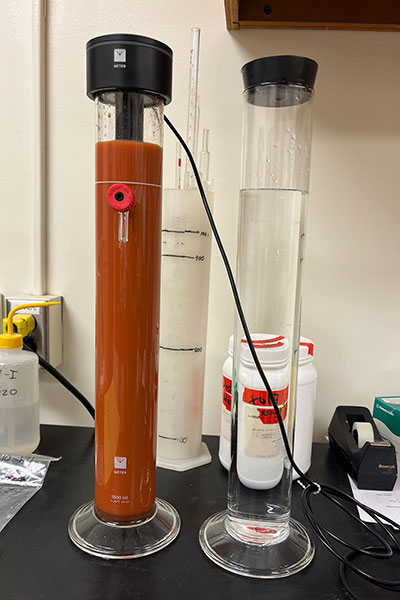
Knauf used a PARIO tool, seen here, to measure the makeup of the different soil samples for his Independent Study research.
At Wooster’s Art Murray Field, Knauf and two teammates used the high-speed camera from their bullpen to capture velocity, spin rate, and movement of the balls after they were rubbed with the various mud samples. He also created a peel test to determine the stickiness of each mud. Additionally, Knauf observed minerals through X-ray diffraction in the XRD lab and evaluated the difference in physical properties of the various muds. Using a new PARIO particle-size analysis instrument that Wooster purchased in summer 2023, Knauf measured the percentage of clay, sand, and silt in each mud.
“I knew I could apply this work to baseball, but it was also exciting to learn how to use different instruments in the lab,” said Knauf. Scovel Hall Lab Technician, Nick Wiesenberg, was a huge help to Knauf in learning how to use the PARIO tool. “We made a few mistakes but were able to learn from them, and we got it done,” he added.
Knauf ’s software analysis determined that the Blackburne mud left more mud on the ball consistently (making it stickier). He found that the special mud contained 50% water and 7% organic material compared to less than 2% in the other samples. “That was the tip-off that the Blackburne mud was really something different,” said Knauf. “Clearly there’s something to it being special.” In fact, it’s so special that the mud’s location is a secret. Each winter, the owner harvests the mud from an undisclosed spot in New Jersey’s Delaware River.
Like the mud’s location, this research is also unique. Though many articles talk about the Blackburne company history, no one has thoroughly covered the stickiness aspect like Knauf. Because the MLB has recently cracked down on using foreign substances to have the stickier feel, Knauf also considered possible substitutions for Blackburne mud. “I found a place in the San Francisco Bay with similar characteristics to the New Jersey river source,” said Knauf. “They both have a semidiurnal tide, meaning the tide goes through the river twice daily. That’s how you get the finely filtered mud.”
Knauf was very satisfied in completing the project, adding that he’ll never forget the feeling of turning it in. “All three graduating senior baseball players turned in their I.S. projects together with our coaches and the entire team there for support,” said Knauf. “That was a cool moment for us as a class. We’ve been through a lot starting college during the COVID pandemic, so it was really fun and rewarding to see their hard work pay off, too.”
Knauf plans to pursue a career or related graduate degree in geotechnical consulting. Though he’s left the Scots roster, he said he’ll be sticking with baseball. “Whether it’s giving lessons or playing in some rec leagues, I definitely want to stay close to the game.”
This feature originally appeared in the Summer 2024 issue of Wooster magazine.
Posted in Independent Study, Magazine on June 20, 2024.
Related Posts
Related Areas of Study
Earth Sciences
Geology, environmental geoscience, geophysics, and other classes that explore Earth and the impact of humans
Major MinorEnvironmental Geoscience
Investigate the impact humans have on the Earth and research ways to solve pressing environmental problems.
Major Minor
